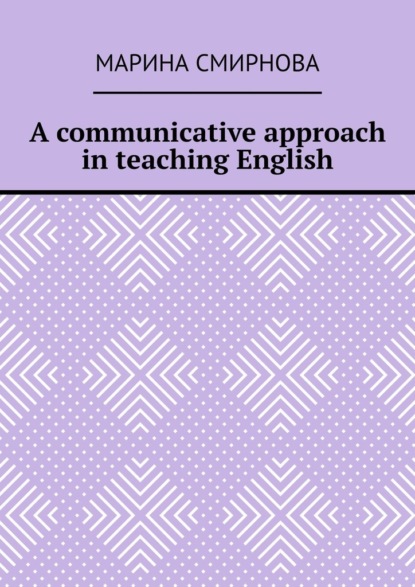По всем вопросам обращайтесь на: info@litportal.ru
(©) 2003-2024.
✖
A communicative approach in teaching English
Настройки чтения
Размер шрифта
Высота строк
Поля
A communicative approach in teaching English
Марина Смирнова
В данном пособии не только описаны основные принципы коммуникативной методики, но также даны многие примеры заданий и ситуаций на уроке со ссылками на интерактивные ресурсы, которые Вы смело можете использовать в своей педагогической практике. Это – краткое руководство, которое всегда должно быть под рукой, чтобы проводить самые интересные, методически выверенные и продуктивные уроки английского языка!
A communicative approach in teaching English
Марина Смирнова
© Марина Смирнова, 2021
ISBN 978-5-0053-8817-9
Создано в интеллектуальной издательской системе Ridero
Dear collegues!
This guide is intended to be used by the teacher of English to make their lessons more effective, creative and teach students to communicate and use English in real life.
I have included all the practical aspects of a communicative approach, its main ideas, methods and techniques and provided the examples of tasks for different levels into this brochure.
I have also attached the examples from my own teaching practice which I successfully apply at the lessons.
You can use them and create your own tasks!
The communicative approach. Its principles
The main approaches to teaching English at school today are grammar-translation and communicative ones.
Most teachers use a grammar-translation method the essence of which is to translate everything into Russian, explain grammar in Russian and do exercises which we call «drills» to practise your language skills.
The drawbacks of such an approach are clear to everyone:
– the students do not get used to speaking English as the teacher and they mainly speak Russian at the lessons,
– the students memorise and learn everything by heart without understanding how to use these constructions in real life,
– the language barrier is large as they don’t communicate and don’t pay much attention to speaking and listening to native speakers.
Nowadays the communicative approach has spread largely in schools, and advanced teachers prefer using it.
Its undisputable advantages are:
– lifelike situation at the lessons,
– the creation of the speaking environment,
– the reproduction of all new structures into speech,
– the practical use of the language.
The principles of the communicative approach are:
– imitating real speaking environment,
– speaking English all the time,
– emerging students into communicative situations,
– encouraging students to talk,
– concentrating more on the speech,
– teaching grammar in context,
– being positive, creative and democratic with the students.
Your first goal is imitating real speaking environment by means of creating communicative situations.
Here are some examples.
Situation 1.
Students – pre-schoolers
Topic: «Toys»
The aim of the task – to remember the words and the phrase: «give me…»
The students have the cards with the toys, they need to complete the full row: the teacher puts the row on the board: a ball, a doll, a car, a soldier. Each student has a card with one toy missing. They need to ask a teacher: «Give me a … (missing card) ” and complete their row.
Situation 2:
Students – adults (elementary)
Topic: «Daily routines»
The aim of the task – to practise Present Simple statements, the question «What time do you..?», remember daily routines.
The students are to make a poll. They can see cards with everyday actions on the board. They ask their partners questions such as «What time do you … (get up)?» and write down their answers on the blank. Then they need to tell the class about their partner: «Mike gets up at 6 a.m., he has breakfast at 8 am…»
The communicative situation imitates real life conditions provoking students to talk.
If these are small kids, it is enough to imitate primitive situations with short simple phrases and sentences. If the students are grown-ups, you need to choose relevant topics and interesting circumstances.
The second important principle is to speak Engish at the lessons. It is difficult to make it understandable for young learners and beginners what to do speaking only English. The tips here may be:
– simplifying the lenguage without using difficult words and structures,
– pacing and gradual presentation of the material,
Марина Смирнова
В данном пособии не только описаны основные принципы коммуникативной методики, но также даны многие примеры заданий и ситуаций на уроке со ссылками на интерактивные ресурсы, которые Вы смело можете использовать в своей педагогической практике. Это – краткое руководство, которое всегда должно быть под рукой, чтобы проводить самые интересные, методически выверенные и продуктивные уроки английского языка!
A communicative approach in teaching English
Марина Смирнова
© Марина Смирнова, 2021
ISBN 978-5-0053-8817-9
Создано в интеллектуальной издательской системе Ridero
Dear collegues!
This guide is intended to be used by the teacher of English to make their lessons more effective, creative and teach students to communicate and use English in real life.
I have included all the practical aspects of a communicative approach, its main ideas, methods and techniques and provided the examples of tasks for different levels into this brochure.
I have also attached the examples from my own teaching practice which I successfully apply at the lessons.
You can use them and create your own tasks!
The communicative approach. Its principles
The main approaches to teaching English at school today are grammar-translation and communicative ones.
Most teachers use a grammar-translation method the essence of which is to translate everything into Russian, explain grammar in Russian and do exercises which we call «drills» to practise your language skills.
The drawbacks of such an approach are clear to everyone:
– the students do not get used to speaking English as the teacher and they mainly speak Russian at the lessons,
– the students memorise and learn everything by heart without understanding how to use these constructions in real life,
– the language barrier is large as they don’t communicate and don’t pay much attention to speaking and listening to native speakers.
Nowadays the communicative approach has spread largely in schools, and advanced teachers prefer using it.
Its undisputable advantages are:
– lifelike situation at the lessons,
– the creation of the speaking environment,
– the reproduction of all new structures into speech,
– the practical use of the language.
The principles of the communicative approach are:
– imitating real speaking environment,
– speaking English all the time,
– emerging students into communicative situations,
– encouraging students to talk,
– concentrating more on the speech,
– teaching grammar in context,
– being positive, creative and democratic with the students.
Your first goal is imitating real speaking environment by means of creating communicative situations.
Here are some examples.
Situation 1.
Students – pre-schoolers
Topic: «Toys»
The aim of the task – to remember the words and the phrase: «give me…»
The students have the cards with the toys, they need to complete the full row: the teacher puts the row on the board: a ball, a doll, a car, a soldier. Each student has a card with one toy missing. They need to ask a teacher: «Give me a … (missing card) ” and complete their row.
Situation 2:
Students – adults (elementary)
Topic: «Daily routines»
The aim of the task – to practise Present Simple statements, the question «What time do you..?», remember daily routines.
The students are to make a poll. They can see cards with everyday actions on the board. They ask their partners questions such as «What time do you … (get up)?» and write down their answers on the blank. Then they need to tell the class about their partner: «Mike gets up at 6 a.m., he has breakfast at 8 am…»
The communicative situation imitates real life conditions provoking students to talk.
If these are small kids, it is enough to imitate primitive situations with short simple phrases and sentences. If the students are grown-ups, you need to choose relevant topics and interesting circumstances.
The second important principle is to speak Engish at the lessons. It is difficult to make it understandable for young learners and beginners what to do speaking only English. The tips here may be:
– simplifying the lenguage without using difficult words and structures,
– pacing and gradual presentation of the material,






